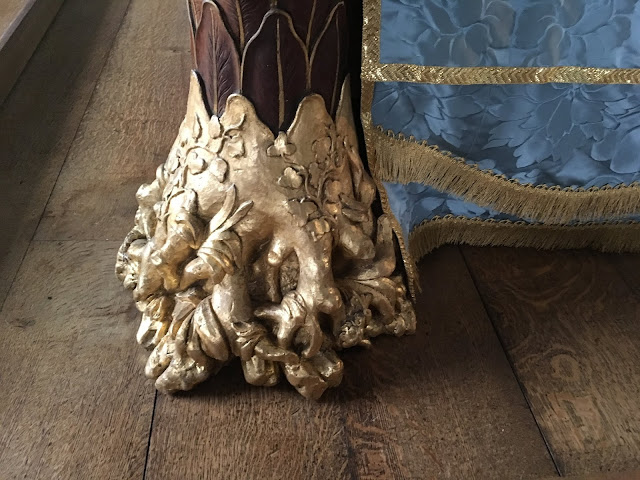July 5 & 12, 2018 - Biddulph Grange Garden and Kedleston Hall
Biddulph Grange Garden
James Bateman and his wife Maria, purchased this property around 1840. They both loved science and botany and began designing and transforming the house and gardens into a pleasure garden for entertaining, that had a teaching agenda, as well.
Wikipedia says the following about this beautiful and interesting garden:
Behind a gloomy Victorian shrubbery there's a gloomy Victorian mansion, but behind that lurks one of the most extraordinary gardens in Britain...it contains whole continents, including China and Ancient Egypt – not to mention Italian terraces and a Scottish glen.
The rhododendrons and azaleas are spectacular in late spring, but the pinetum and the evergreen topiary provide year-round interest. It's a fantastic garden for children, with its tunnels and rockeries, and there is a children's quiz trail.
The true brilliance of Biddulph Grange lies in the way that Cooke and Bateman hid the different areas of the garden from each other, using heaps of rocks and thickly planted shrubberies' the design locks together as tightly as a jigsaw or a cross-section of the brain. It contains a series of Italianate terraces, connected by steps and enclosing small flower gardens' at the bottom, long, buttressed hedges enclose a dahlia walk. In the Egyptian part of the garden, two sphinxes guard the mastaba-like entrance to a tunnel, whose darkness is an invitation to explore. Deep inside is a bloody chamber (lit by a hidden window of red-coloured glass) in which squats the half-spooky, half-comic figure of the Ape of Thoth.
The building in the picture below is no longer associated with the garden, in that the original manor house burned down, was rebuilt, and then was used as a hospital and other things. The National Trust purchased the garden, but they do not run the "house."
The original owner was a bit of a geologist, and he had quite a collection of rocks and fossils. He believed in creationism, so he designed a hallway leading from the house to the garden that represented six days of the creation, with fossils from his interpretation of each "day" or period. He loved to entertain, and he would lead his guests down that hall, while presenting his ideas on the creation of the world. The door leading from the hall out to the garden was supposed to represent walking into the seventh day and he would then send his guests out from there, to explore and enjoy. The Trust is currently working to restore the hallway to how it was originally.
The garden is amazing, with may interesting surprises throughout.
There are man-made caves and tunnels throughout the garden that lead from one "continent" to another.
They built a high, stone tower from which to observe the beautiful specimen trees.
We didn't know about this before visiting gardens in the UK, but many of the major gardens have a "stumpery," or area of the garden in which old stumps are artistically arranged. The stumpery in this garden was fantastic!
Kedleston is the manor house that is closest to where we have been living. Wikipedia says the following about it:
Kedleston Hall is an English country house in Kedleston, Derbyshire, approximately four miles north-west of Derby, and is the seat of the Curzon family whose name originates in Notre-Dame-de-Courson in Normandy. Today it is a National Trust property.
The Curzon family have owned the estate at Kedleston since at least 1297 and have lived in a succession of manor houses near to or on the site of the present Kedleston Hall. The present house was commissioned by Sir Nathaniel Curzon (later 1st Baron Scarsdale) in 1759.
Kedleston was featured in the Keira Knightley film, The Duchess.
They were preparing for a wedding while we were there, and Hannah couldn't resist the opportunity to have a go at being on one of her favorite shows, The Great British Bake-Off.
Can you find Heather in the picture below? The grounds are extensive! She is actually standing at the edge of the turf lawn, with a 10 foot stone wall below her, that drops into a sort of moat or ditch that surrounds the house and other structures. The area beyond is many acres of walking trails, woodlands, and pasture, all part of the estate. In older days, it would have been protected hunting grounds.
The gold trim and thread on this bed and the bedspread is truly gold! Crazy!
We were impressed by the curved doors that fit the curved walls!
This is a picture of the woman of the house wearing a magnificent, peacock dress that was hand embroidered of gold, silver, and copper threads, with gems. She only wore it once, but made quite a splash! The dress is on display in the house's museum. After the years of sitting, it's opulence has faded a bit, but it is an amazing thing to see.
They had a woman, dressed up and acting as though she were the Head Housekeeper, who ran the house for many years. She talked about how the house once was, and what many of her tasks included. A painting of the real woman can be seen below. It was fun to step back in time.
The floor in the picture above, was laid with curved oak boards! We are not sure how that would even be accomplished. Some of the thick and wide boards in the floors of these old houses, attest to how big the trees must have been that they came from. We have seen some floor boards as wide as 14 to 15 inches, covering huge rooms!
The basement of the house is a museum containing many interesting things the Curzon family collected on numerous trips abroad.
Before going home, we enjoyed this impressive, hollowed-out tree, still alive and growing.

























































Comments
Post a Comment